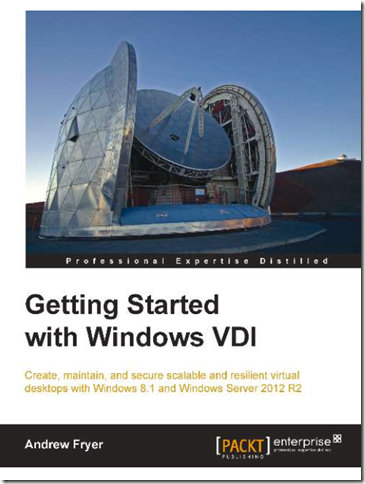VDI–Shameless plug
I have spent the last six months writing my first book, Getting Started with Windows VDI for Packt Publishing, basically because I want to create a one stop repository of the key elements you need to do this. The basic idea I had was to only use the Microsoft stack to do this and to explore the wider aspect of VDI in the process:
- Building the VDI template using the Microsoft Deployment Toolkit (MDT) where this is normally used to create images that are deployed to physical desktops.
- Use of the Microsoft Desktop Optimization Pack (MDOP) to virtualize applications (App-V) and user settings (UE-V) so that users can get the resources they need whether they are using VDI or not.
- How to enable High availability for VDI for each of the component parts. For example more than one the broker can be used by setting up a shared SQL Server database to store metadata about the deployment such as who is logged into which desktop and what Remote App Applications can they use.
- Using WSUS to update the deployment by integrating it with MDT to refresh the virtual desktops and also what needs to be done to patch the role services and hosts.
I have tried to be as honest as possible as I would rather maintain my integrity and stop you wasting time trying to get stuff to work which is not optimal. A good example is the big debate of Terminal Services (which I refer to as Session Virtualization) vs a collection of Virtual Machines each providing a virtual desktop which is what most people mean by VDI. Session Virtualization is still much more efficient than using individual VMs to provide virtual desktops by factor of 10 or 20 so you won’t find me defending VDI. Rather I have tried to explain when to use what and that using a blend of both with a common infrastructure is the best approach as this is very easy to do in Remote Desktop Services in Windows Server 2012R2.
I also wanted to make it a practical guide but you’ll need a fairly beefy box (i7 16gb RAM) and ideally an SSD to run all the VMs if you want to try it. I have also included as much PowerShell as possible in there, as you’ll want to automate as much of this as possible. I have also included a basic guide to licensing VDI as this is one of the main barriers to adoption.
So I hope you get as much out of it as I did in writing it and just one thing to note - If you buy the paper edition the code samples you need are here as some of my PowerShell scripts are too long to be inline in the book and I am old enough to remember how tedious it was copying lines of code out of a magazine to get a game to run!
